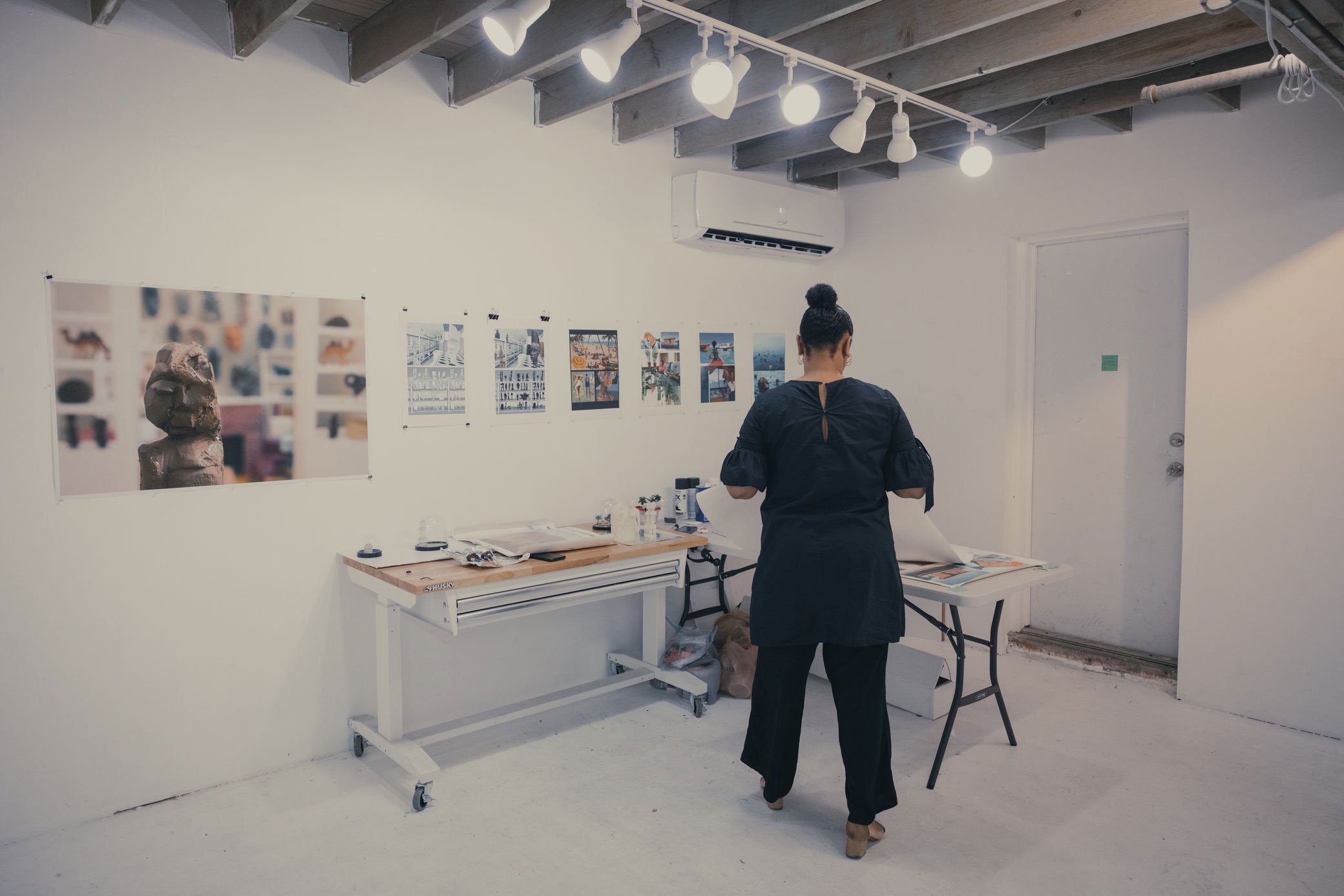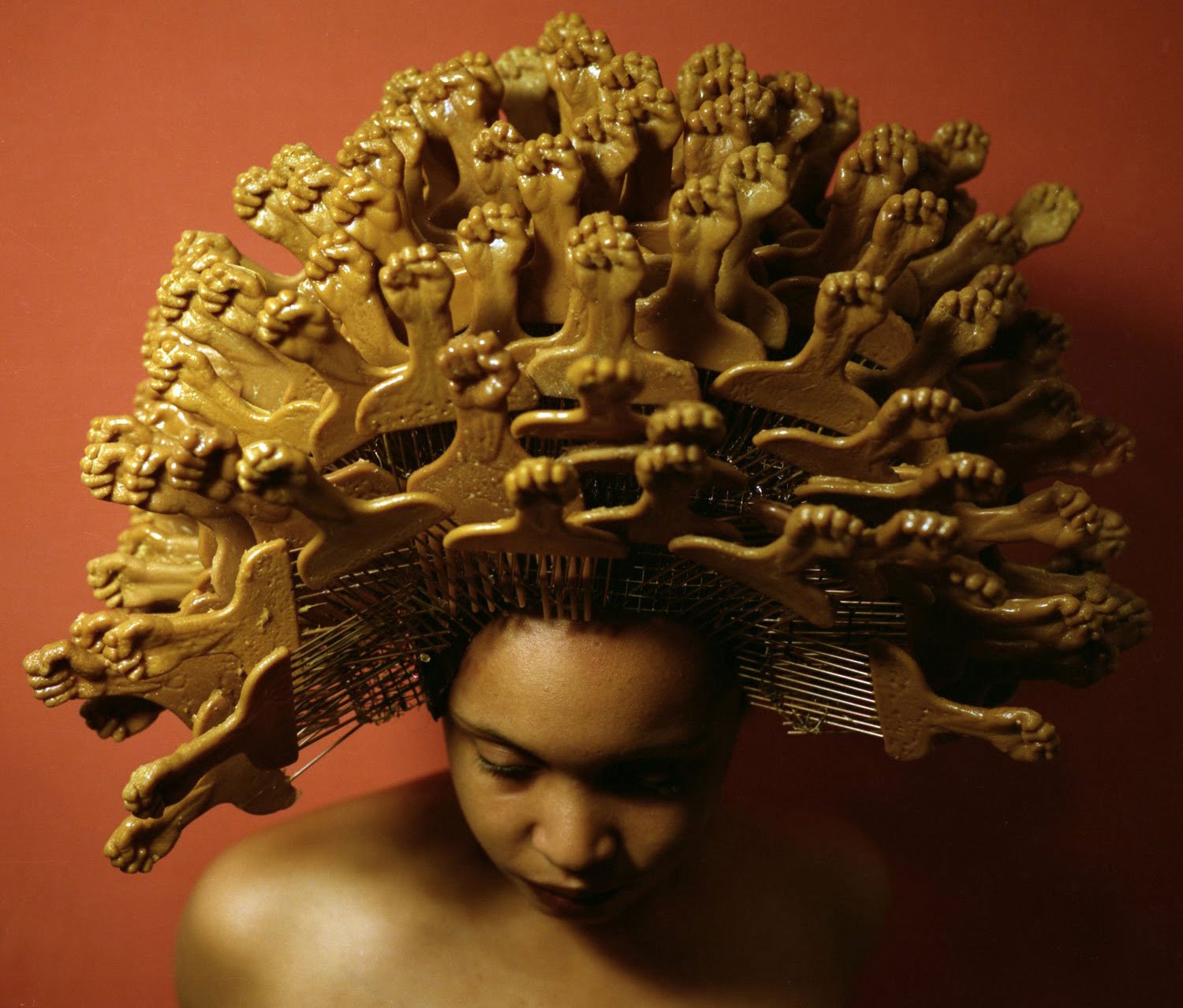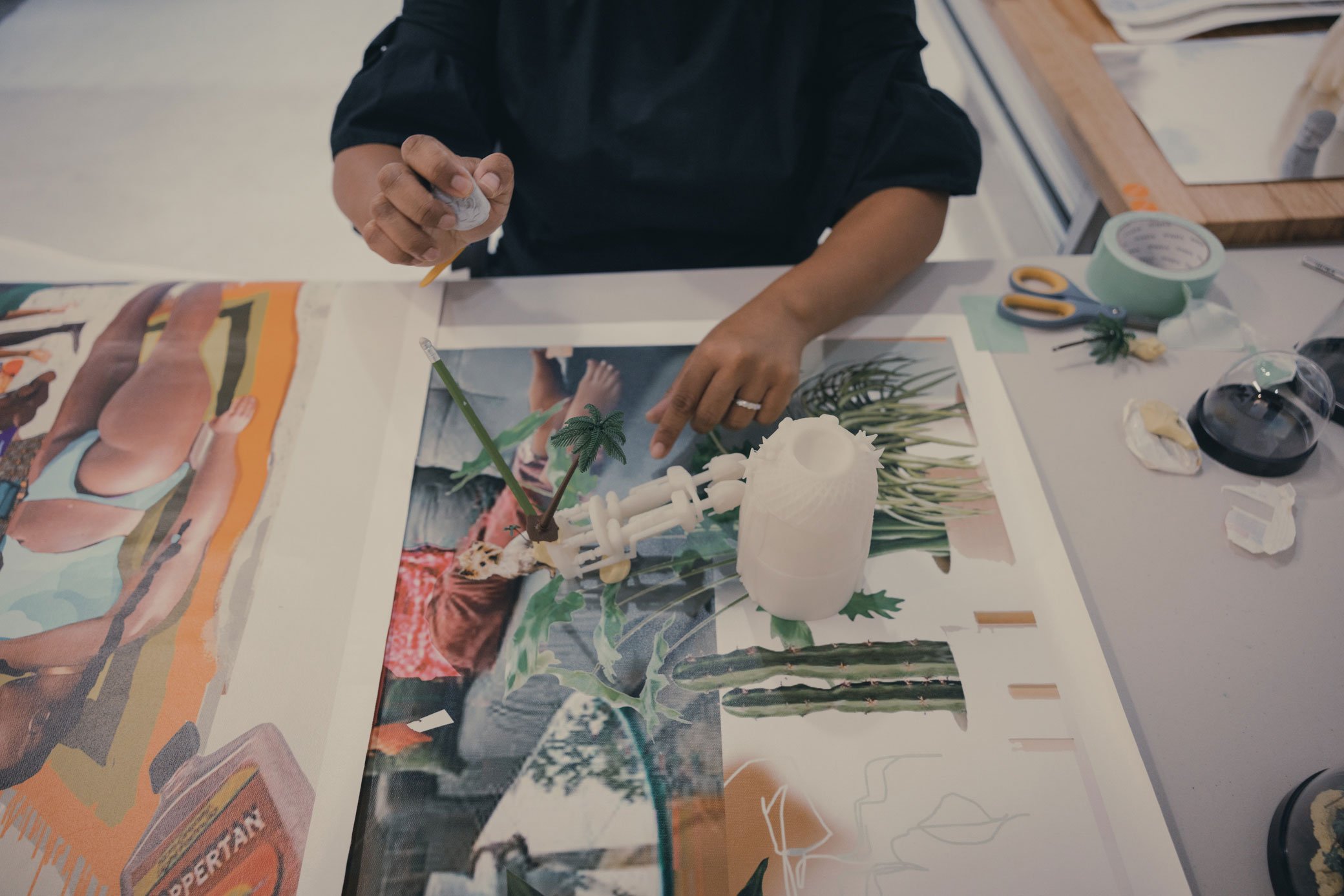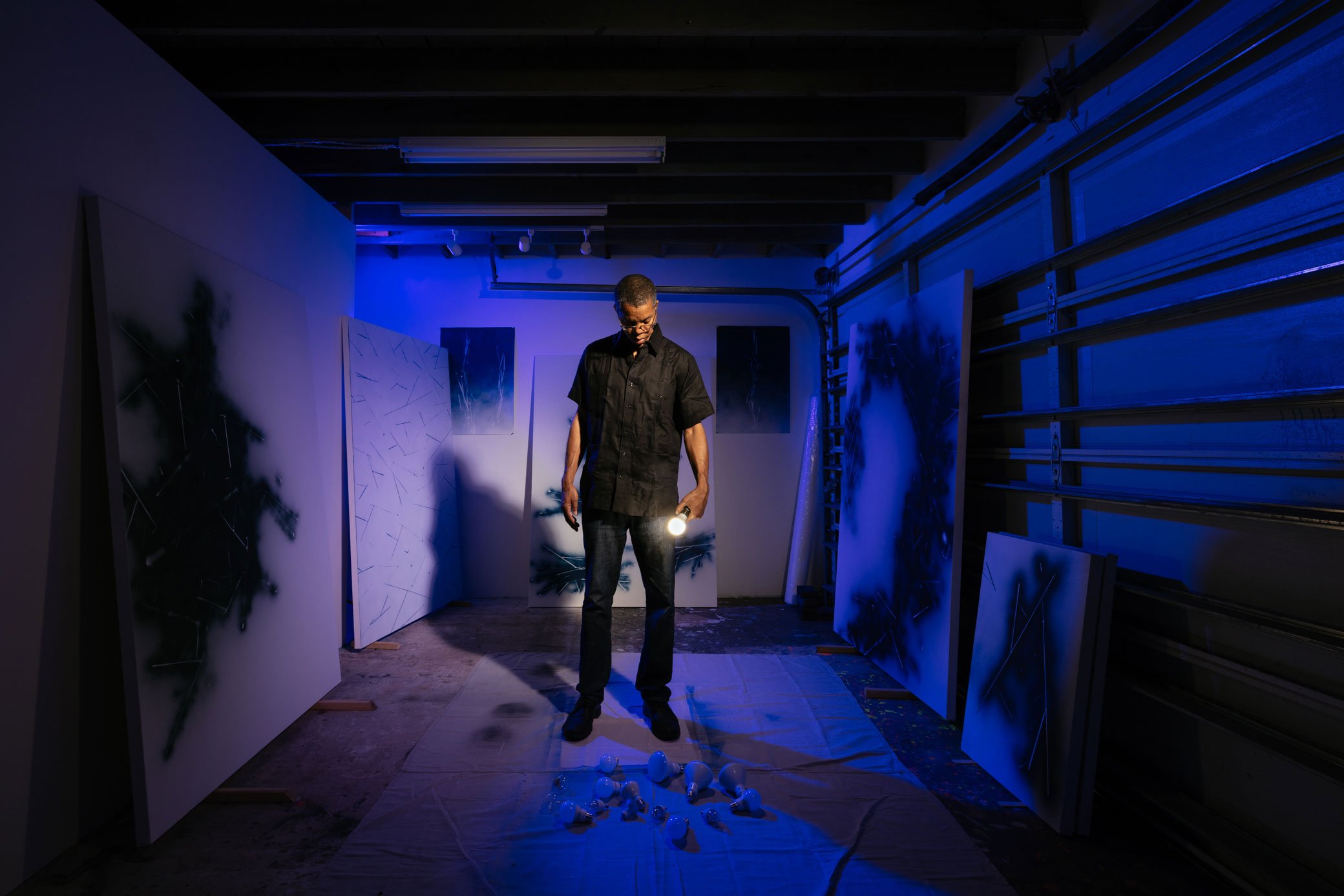
May
Partners in Life and Art
by Clayton Campbell
This month’s residency was generously sponsored in part by Artis and the General Consulate of Israel.
A creative career requires an enormous amount of energy, investment, and belief in oneself. Fountainhead’s themed residency, Stronger Together, Partners in Life and Art, considers how creativity emerges when romantic partners create together. A creative partnership can sustain and push the partners far beyond the point they might have reached on their own. Personal and professional collaborations often combine complementary skillsets and points of view to create something larger and unique. Stronger Together united two couples, Demetrius Oliver and Lauren Kelley, and Merav Kamel and Halil Balabin, who exemplify this idea for different reasons.
Creative partnerships in the visual arts bring to mind many other creative couples, like Christo and Jean Claude, Rauschenberg and Johns, Krasner and Pollock, or Thelma Golden and Duro Olowu. One model is close collaboration, like artists in residence Merav and Halil. A second model is when each is pursuing separate practices, like Oliver and Kelley. At the heart of successful life and art partnerships is a deep love and respect for each other, for the creative process, and a shared belief that what they are doing as people and artists matters.
A residency has an uncanny way of bringing what is important into focus. For the two couples in residence, it was a rare opportunity to share their experiences.
Kamel and Balabin expressed that “during our wonderful time at Fountainhead, the Stronger Together issue raised a lot of conversations and reflections with Lauren and Demetrius and other couples we met. It was interesting to compare tendencies and different rules one takes in shared dynamics. It’s beautiful and interesting to see that there are so many ways of being and working together.”
Receiving emotional and creative support from a partner can have a positive impact on an artist’s confidence as they make various decisions about their future. Merav and Halil are life partners who collaborate closely in their artmaking. Their practice arises out of their collective intuition as they follow their instincts toward the creation of works that fuse nonsense and humor with history, sexuality, and fantasy. Together they work with materials like wood, metal, fabric, and cardboard to create sculptural dolls and large-scale drawings. Living and working jointly since 2012, they say they feel “stronger together most of the time, and sometimes weaker together, and then we try to create private spaces within the collaboration.”
The arts are a highly competitive field. In Merav and Halil’s mutually supportive practice, “when it comes to competition, in many ways, for us, standing together in front of the world, the fact that we are signed on the works together and exhibit them together, makes it possible to break free from competitiveness and ego,” they say. This perspective is essential to sustain a truly creative vision.
What happens when both partners are pursuing creative careers but in different ways? Oliver and Kelley are partners in life, but they each have their own distinct practice. While both are intrigued with materials and objects as a point of inception, Oliver’s photography, video, sculpture, and drawing are concerned with natural phenomena occurring in our physical and spatial plane and lean heavily away from being autobiographical. Kelley, on the other hand, is a storyteller who uses film, photography, animation, and collage to explore historical narratives
surrounding Black female strength, at once personal to her as a Black woman. Being at Fountainhead opened their perspective on how they are stronger together. Kelley and Oliver shared, “while we have always had very independent practices, this residency has allowed us to more closely acknowledge that we share a love of objects.” Oliver works conceptually through painting, sculpture, and photography. Kelley is more tactile in that at the core of her studio exploration is stop-motion animation. The residency helped them reflect on the knowledge that their work is aligned in being engrossed by the world around them, “which sometimes is triggered by encountering/ examining found objects.”
When asked if other artist couples came to mind when thinking about their relationship, Kelley expressed that “From a Black art historical slant, maybe our dynamic evokes the chemistry of Jacob Lawrence and Gwendolyn Knight, two artists making very different work while maintaining a steady, drama-free relationship.”
Collaboration in life and art for Oliver and Kelley is transformed into selfless support of each other, offering the best and most honest feedback they can give. The creative partnership of Merav and Halil is also based on deep trust. Many artists work alone, without the benefit of a partner’s support. Partners who work and share together can provide crucial feedback when the other is struggling with an idea and trying to find creative solutions to realize it. In a full partnership, each wants better for the other person than they do for themselves. This space of generosity and care is the grounding for their practices and relationships in life and art.
Merav
and Halil
As partners in life and work, Merav Kamel and Halil Balabin’s artistic practices arise out of their collective intuition: They follow their instincts toward the creation of works that fuse nonsense and humor with history, sexuality, and fantasy. Working with materials like wood, metal, fabric, and cardboard to create sculptural dolls and large-scale drawings, in a process they have called ‘blurry’ and even ‘stupid’—a reference to the freedom of judgment they hope to lend themselves while working toward its final stage. Once they think they might be there, they step back and analyze what the work is ultimately trying to say. Their doll-making, coupled with their individual drawing practices, is often based on an inside joke or ironic anecdotes they encounter in their everyday lives and was born out of their relationship. They started making the dolls as gifts to one another, began selling them at fairs soon after, and later developed them conceptually to widespread critical claim.
The drawings, made of watercolor and ink, are engraved into the paper in a process the artists akin to tattooing on skin. Because the technique requires them to work quickly, the drawings have a spontaneous quality to them. The sculptures are likewise guided by this innate motivation and encompass assemblage techniques driven by the material they choose to work with for each individual piece. Merav and Halil’s collaborative work is part of the collections of the Tel Aviv Museum of Art and the Israel Museum in Jerusalem and has been exhibited in Germany, the United States, and the Czech Republic, among others. In Miami, they prepared for a solo show at the Israel Museum, opening January 2023. Merav Kamel was born in Tel Aviv, Israel, and Halil Balabin was born in Jerusalem, Israel. They both live and work in Tel Aviv, Israel.
Clockwise from left: Merav and Halil at work in their studio at Fountainhead Residency, photographed by Pedro Wazzan; Apple Power, 2021. Wood, fabric, and metal; Merav and Halil preparing for their Open House; and a portrait of the artists, both by Wazzan.
Lauren
Kelley
Lauren Kelley is an interdisciplinary artist who employs a wry wit when commenting on matters of innocence, race, and girlhood. At the core of her practice is a series of short, stop-motion animated videos that combine claymation with her brown, plastic dolls. Stylistically evocative of the children’s television programs of her youth, Kelley stages absurd, jittery, and sometimes endearing narratives. These low-tech scenarios occur in her Technicolor dioramas; a plush backdrop in contrast to the flaccid tales of a discontented cast of ingénues. For Kelley, dolls are a vehicle for navigating the space between luxuries and necessities; sweet and unsavory sentiments; Black and non-black worlds. Currently, she is developing a body of work inspired by mid-century American history and the grotesque charm of Todd Haynes’ 1988 cult classic, Superstar: The Karen Carpenter Story.
Kelley’s process is a tactile endeavor that revolves around objects and images of objects sourced from eBay. Apart from utilizing dolls, she pursues items that are malleable or evoke an off-kilter aura. Similar to digesting fiction and people-watching, browsing online also spurs the impetus for constructing her vignettes. Found imagery informs the production of digitally collaged storyboards, miniature sets, photos, and independent sculptures. Her freestanding works buttress the videos and allow for storylines to unfold incessantly. Her work has been exhibited at the Studio Museum of Harlem, Tang Teaching Museum at Skidmore College, and PPOW in New York. She is a Creative Capital grantee and the former director of the Sugar Hill Children’s Museum of Art and Storytelling in Manhattan. Kelley was born in Baltimore, Maryland. She lives and works in Harlem, NY.
From left: A portrait of Kelley in her studio in collaboration with Pedro Wazzan; Pickin’, 1999. Archival ink jet, courtesy of the artist; images of Kelley at work in her studio at Fountainhead Residency, photographed by Wazzan.
Atmospheric, architectural, and immersive in its form, Demetrius Oliver’s work is concerned with natural phenomena that occur in our physical and spatial plane. Examining the different properties and behavior that might make up our visual interpretation of a hurricane, a meteor, or a thunderstorm, Oliver attempts to conjure that sensorial experience within the boundaries of an art gallery. Whether working with installation, photography, sculpture, or drawing, he observes how space, time, light, sound, and color are manipulated through meteorological events, and suggests those encounters as acutely as possible: Viewers, for example, may only be able to access his gallery shows if the sky is clear enough to see the stars.
His process begins with sourcing prosaic materials that he discerns are open enough to be manipulated according to his needs, such as coal or tires; and he frequently works with the same kinds of objects sourced from different places and experiences. Once he’s selected his materials for a particular project, Oliver will consider a space’s floor plan before he begins making particular works of art since all of his projects are designed to punctuate a room. The finished result is less about understanding the artists’ intentions and more about the felt experience of living within the elements. His work has been most recently featured in the Virginia Museum of Fine Arts along with solo shows at Klaus von Nichtssagend gallery in New York and Inman Gallery in Houston. He is a recipient of a Joan Mitchell Foundation grant and is an alumnus of the Studio Museum in Harlem residency program. Oliver was born in Brooklyn, NY. He lives and works in Harlem, NY.
Demetrius Oliver
Clockwise from left: Crystal Sky, 2021. Enamel on canvas; a portrait of Oliver and images of his work in the studio, all shot by Pedro Wazzan.
Merav and Halil, Flashing, 2022. Wood and epoxy clay. Photo credit Eli Posner.
Merav and Halil, Saddam, 2018. Fabric.
Merav and Halil, The Hot Dog Man and Distance Thief, 2020. Engraving in aquarelle on paper. Photo credit Lena Gomon.
Kelley, Working in studio on snow globes, 2022. Acrylic dome and plastic trees.
Kelley, Untitled Storyboard, 2022. Ink jet print on canvas.
Kelley, True Falsetto, 2011. Single channel video with sound. Photo credit Lauren Kelley.
Oliver, Electric, 2021. Enamel.
Oliver, Ultraviolet, 2021. Enamel.
Oliver, Untitled, 2021. Enamel.





















